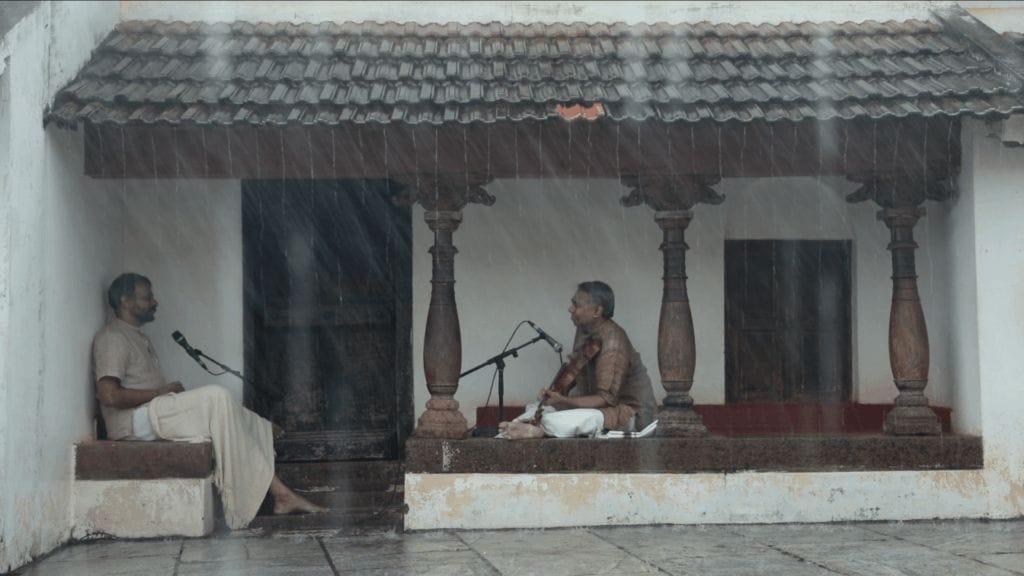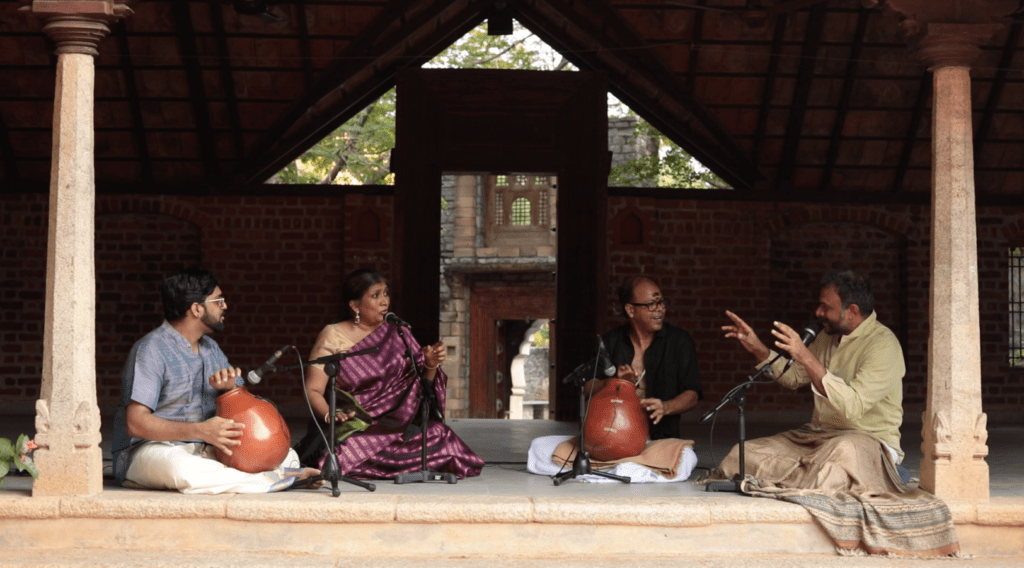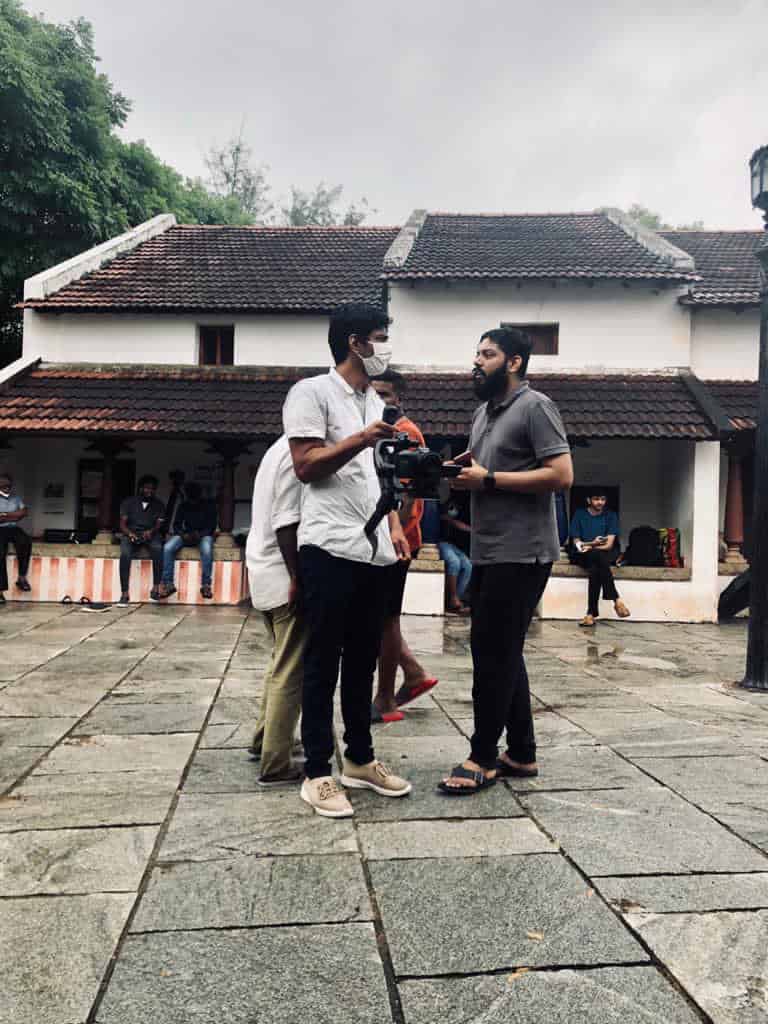It was pouring, as happens in December sometimes in Chennai. But the four musicians getting drenched did not pack up. They played on, completing the two hour video, called “Friends in concert”, which was unlike any classical concert Chennai has ever seen.
“Friends in Concert” opened the traditional Margazhi (December) Madras Music season in these extraordinary times in the most extraordinary manner. And musician T M Krishna, as he is wont to do, was breaking all rules of the kutcheri format for Carnatic classical music followed in the hallowed sabhas of Chennai.
It was the first time this season that a monetized digital format made available for viewing on a single ticket (Rs 2500) for 48 hours was being tried out.
It was also a portent of what the cultural scene in Chennai is likely to be in 2021—-recorded concerts using all the gimmicks and effects that digital technology makes possible.
The new digital formats
The novelty and exploration of different angles and spaces of this two-hour recorded concert were aspects that only a digital format could make possible.
For one, there was no lead singer, hierarchies were broken as all participating musicians were treated as equals and there were more musicians than one normally saw and heard in the standard kutcheri.
Here was Krishna, sitting with violinist R K Sriramkumar on the pyol (thinnai) of a traditional house in Dakshinachitra heritage museum and allowing the violin to take the lead over voice, exploring raga after raga in the rain.

“Friends in concert” was directed by Carnatic musician Rithvik Raja, who has chosen Carnatic music over serious engagement with cricket as a career choice. “I felt that it was important to reimagine and conceptualize a new visual and aural aesthetic for this digital space,” said Rithwik.
“The aim was to recreate the live concert experience and offer a perspective on what is possible in this day and age through technology,” added Rithwik. “Visually, though the focus is on the music, it is also on the camaraderie and friendship they all share. It gave me a unique insight into each of their character, artistry, and their relationship with each other, which is what I wanted to capture and bring to the screen”.
Tradition, what tradition?
The kind of liberties T M Krishna took with the music and the musicians in this concert would have been unthinkable earlier in Chennai’s sabha scene. Every year, the city’s culture world gears itself for a shower of music in the in the first week of December reaching its peak in the last two weeks of the year when the Madras Music Academy finishes its music conference, the festival’s finale.
Performing in Madras was the dream of every Bharathanatyam dancer and classical musicians of all forms. The NRI crowd made a beeline to Chennai in December and some Sabhas were happy to get sponsorships from the artistes themselves to present them. This happy win win situation will now have to adapt to the new post Covid normal.
Ananda Shankar Jayant, a senior officer in the railways and a Bharathanatyam dancer of repute heads to Chennai every December. But now her alma mater Kalakshetra is selling only 80 physical seats per concert and digital access for others.
“This hybrid model of live plus digital will continue in 2021,” says Ananda. “The digital space will get more professional and creative. There has been a democratisation of the performance spaces and options. No one needs a presenter/organisation now”.
Curation and presentation is a learning required by organisations and artistes moving from the physical to the digital. Issues like copyright and ownership of the art works etc need to be understood clearly. Artistes would do well to upgrade their knowledge on these issues, so that they don’t get taken for a ride.
But to how monetise the digital shows?
Monetisation of digital presentations, however, will continue to be uncertain, and unlikely to cover the cost of producing a digital presentation. Popularity based on likes and views online may not be enough for financial viability.
There is a possibility of ennui and boredom from excessive digital viewing. So new and innovative ways of packaging content is emerging, especially its duration. On digital platforms, what used to be a 3-hour show is being compressed to about one a half hours.
“This requires an upgradation of one’s skill sets, both artistically and technologically,” says Ananda. “The digital space is great for theoretical workshops, and has proven to have wide reach. We had sessions called Natyashala in August which were sold out, with entries from across the world”.
The dancer till now has been supporting all the necessities for presenting her dance by getting the sponsorships, spending on musicians and the sound and light systems etc (average cost of a performance varies from Rs.10,000 to Rs 1 lakh depending place, duration and format).
But in a hybrid atmosphere, she will have the additional expense of videographers and editors. This has been a particular problem with the Chennai music and dance scene because of the great desire of artistes to perform her
A bit of history
The Madras music season was born just after the 1927 Indian National Congress meeting in Madras. A festival of music was organized on the fringe of this important political gathering and became the precursor for the Madras Music festival.
The Marghazhi month falling between December 15th and January 15th was anyway kept aside as a time for devotional singing in the Hindu tradition. No marriage or other festive occasions took place in Margazhi. Early morning processions of singing bards going around in Uncha vritti (seeking alms) dominated the days before the winter Sabarimalai pilgrimage became fashionable.
The social, political and religious churning of the thirties had its lasting impact on the cultural thinking and presentation. A whole new way of presenting music was brought into effect by the likes of Ariyakudi Ramanuja Iyengar.
Music picked up tempo, the raga elaborations were shortened, Bhakthi lyrics of Tyagaraja became the staple fare, rhythm got centre stage with the Tillanna ending the concert. A particular repertoire order was brought in and the time allotted for the percussion flourishes etc.
Almost to a century later, all this is changing. New challenges have been thrown up in the cultural scene due to the new normal created by the pandemic. Already, a new sociological churning is happening in the cultural scene spearheaded by tech savvy young musicians and dancers who are presenting themselves in different ways in cyberspace and the myriad questions young dancers are asking about the cultural and sociological history of performing arts.

Free to experiment
Repertoire is going through an overhaul and presentations are using technology in different ways. Shaale.com, the platform which live streamed the “Friends in Concert” anticipated what was coming and Skanda, its founder, gave up a career in IT to start this streaming platform and begin online courses in Bharathanatyam and Carnatic music.
Kalakendra, a digital platform, had begun to record classes and performances and learning through videos in a small way earlier which were quite popular among the diaspora dance world. They were also live-streaming programmes.
Now they expanded their offerings, curating “Yours Truly Margazhi” as a consortium of federation of Chennai sabhas, livestreaming over a hundred performances with over 250 artists, besides recorded music, dance, drama, harikathas, devotional music events etc. Access is priced at Rs.3650 for Indians and US$50 for viewers abroad.
Shooting schedules have been going on in the hallowed precincts of Kalakshetra and other exotic locales. Most importantly, the concerts have gone outdoors with musicians singing on the steps of a lily pond or in the open in a temple precinct. Reputed musicians like Sanjay Subrahmanian, Ramakrishna Murthy, Lalgudi Krishnan and other leading names are taking part in these recordings.
If the internet and skype were the last decade’s alterations, live streaming platforms are the trend of the next decade. One can now see the artiste’s finger tapping on the mridangam and the eyes of wonder in Abhinaya of a dancer in close up, without having to commute to a sabha to physically savour music and dance of great quality.
New talent is coming out in droves, with creative ways of storytelling, sharing knowledge and having gupchups, all in cyberspace.
One such group is Aalaap, a music and dance events company founded by Akhila Krishnamurthy, which early during the lockdown period began creating digital platforms where artists interacted each other and shared their concerns. Aalaap, working in tandem with Shaale.com, also has sold digital access at Rs 300 to a work in progress of Dakshina Vaidyanathan in Delhi and Parshwanath Upadhye in Bengaluru as a curtain raiser for the Margazhi season.
Tricky digital space
Some artists and schools of dance and music have begun their own digital music and dance festivals. Many have been creating unique content on arts, having master classes, conducting on line arangetrams, and recording learning capsules.
Ananda Shankar Jayant’s Natyarambha’s Kutti Kahani (Young Storytellers) series has become immensely popular on social media. Kutty Kahani is a short story video series by artistes in the 6-13 age group.
This is a multi art, multi lingual, (with subtitles as needed) story telling session by young storytellers from across India, Malaysia, Singapore, UK and USA creating ready to access digital Indic content for children. Chanting, music, dance, poetry, puppetry and acting are used for storytelling by children in short-sized video capsules of about 5 minutes.
The videos sent by the children are enhanced with the addition of animation available for free viewing at natyarambha’s YouTube channel
But going digital also creates its own problem. For instance, audience complaints were heard that the 90-minute Sanjay Subrahmanian concert had 73 minutes of advertisements. While some others felt when anything is given free, the viewer becomes the guinea pig.
The criticisms aside, the churn is on, and classical traditions are getting an inevitable digital makeover. Maybe one can expect digital walking musical tours in the days to come. So stay home and travel the world with culture in 2021.

